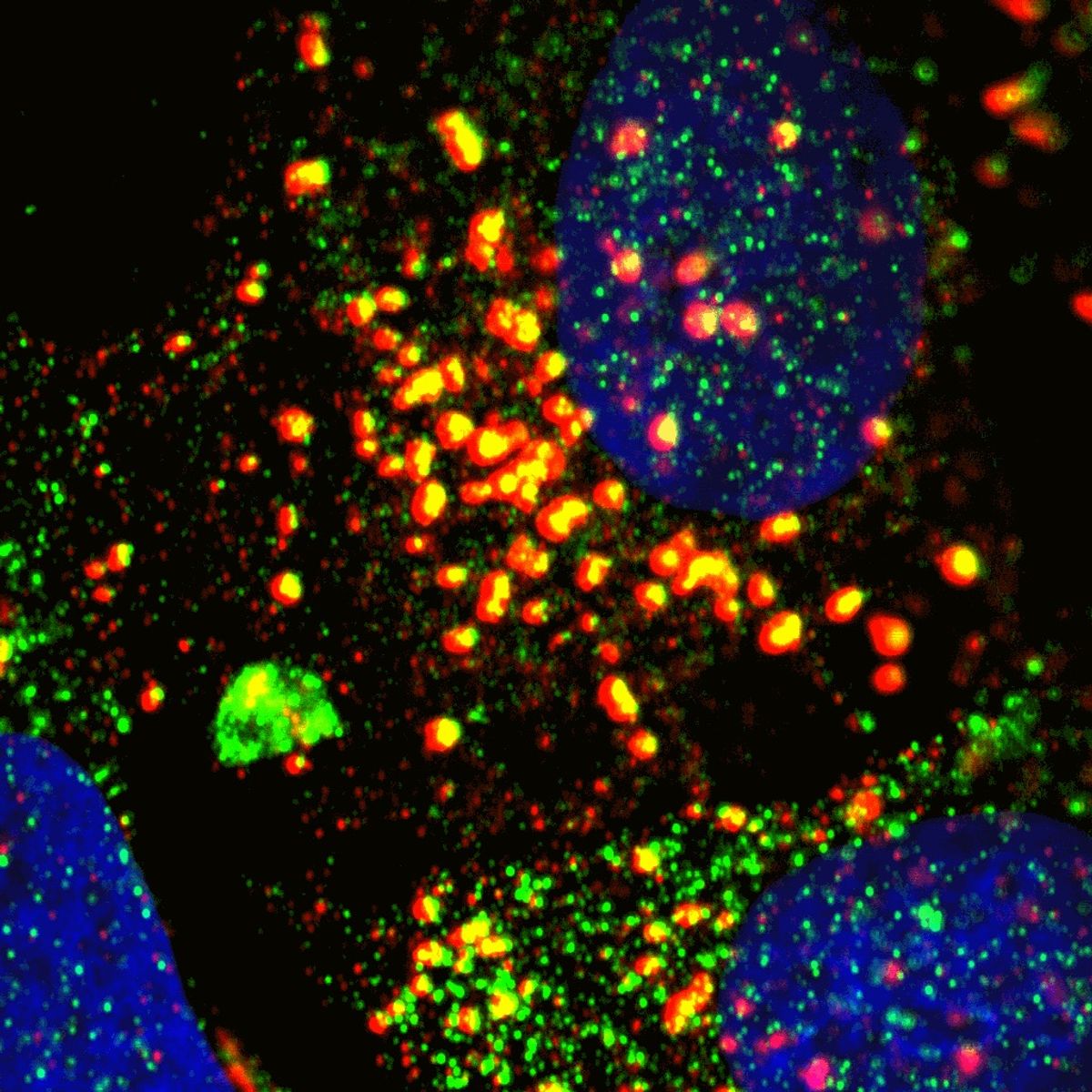ABOVE: Across two papers, researchers highlighted key mechanisms that unlock calcium from intracellular stores. © iStock, Yuuji
Calcium triggers a variety of biological processes, but some of the upstream mechanics regulating its release eluded scientists for decades. Now, an international collaboration led to two papers published in Science Signaling on the mechanisms that open calcium floodgates, revealing a potential route to novel therapies while settling a debate along the way.1,2
Ion channels expressed on organelles act like gatekeepers, controlling the passage of calcium from internal stores into the cytosol. Nicotinic acid adenine dinucleotide phosphate (NAADP) is one of many keys that unlock the gate. First discovered in the late 1980s in sea urchin eggs and later found in mammalian cells, NAADP triggers calcium release from lysosomal stores via ion channel activation, specifically a two-pore channel (TPC).3-6
“NAADP is a very curious second messenger,” said Jonathan Marchant, a cell biologist at Medical College of Wisconsin and coauthor on the papers. Although a potent trigger for calcium release, researchers never discovered a direct binding site, or keyhole, for NAADP on TPC. Then, two papers published in 2021, including one from Marchant’s team, provided a missing link.7,8 The studies revealed the molecular identity of a protein, Jupiter microtubule-associated homolog 2 (JPT2), that facilitates NAADP binding to TPC. If NAADP is the handle of the key, then JPT2 is like the blade that slots into the TPC to open its floodgates.
Adding to the excitement in the field, another paper published later that year identified another blade—the protein like-Sm protein 12 (LSM12)—that linked NAADP to the TPC.9 “People always joke that you wait for a bus to come along, and then three buses come at the same time,” said Marchant. Following the emergence of two promising regulators of NAADP, many researchers questioned potential redundancies, suggesting that one protein may be more important than the other.
See Also “Scientists Uncover Major Pathway Cells Use to Mend Leaky Lysosomes”

To determine which protein was the bona fide key blade for NAADP, Marchant, along with coauthor and postdoctoral researcher Gihan Gunaratne, performed a tightly controlled side-by-side comparison of JPT2 and LSM12.1
For this, they examined three criteria: selectivity, binding, and essentiality. First, JPT2 and LSM12 exhibited selective and high-affinity binding to NAADP, as measured by both radioligand binding assays and biolayer interferometry (BLI). The latter is an optical biosensing technique that provides insight into the binding kinetics of NAADP. Dipping a probe coated in either biotinylated JPT2 or SLM12 into wells containing NAADP allowed the researchers to track protein binding in real time. Compared to wells containing NADP—a similar molecule that does not trigger calcium release—JPT2 and LSM12 demonstrated significantly higher selectivity for NAADP.
Next, to test whether the two proteins also slot into TPC, Marchant’s team performed immunoprecipitation experiments. They found that both proteins interacted with TPC in an independent manner. Lastly, in vitro knockout experiments revealed the necessity for both JPT2 and LSM12 for not only unlocking calcium signaling but also other NAADP-dependent cellular functions. When the researchers added NAADP to cells lacking either JPT2 or LSM12, they did not observe increases in cytoplasmic calcium, whereas JPT1 knockout cells exhibited elevated calcium. TPC activity also plays a role in viral trafficking in the endolysosomal system. When Marchant and his team monitored the transit of different coronavirus spike proteins in cells, they observed reduced infection in cells lacking JPT2 and LSM12. These findings suggest that the NAADP-binding proteins, in addition to gating calcium release, play an integral role in mediating viral escape from lysosomes.
“The remarkable thing about this latest paper by Marchant's group is they seem to suggest that you need both JTP2 and LSM12 to bind NAADP and interact with the channel to open it,” said Antony Galione, a pharmacologist at the University of Oxford who was not involved in the study. “One binding protein loaded up with NAADP is not enough, which is quite controlled regulation, really.” Thus, TPC have a double lock system in place to gate NAADP-dependent activities.
TPC are just as curious as NAADP. Scientists long believed that ion selectivity was an immutable characteristic of ion channels. However, scientists discovered that TPC also regulate sodium via the direct binding of phosphatidylinositol 3,5-bisphosphate (PI(3,5)P2).
Sandip Patel, a cell biologist at University College London and coauthor of the papers, helped discover two small molecules that trigger either calcium or sodium release from TPC, providing a synthetic means of regulating channel activity.10 In the accompanying paper, Patel teamed up with Marchant and Taufiq Rahman, a pharmacologist at University of Cambridge to test whether the synthetic agonist that mimicked NAADP similarly required both proteins to evoke calcium signals.2
See Also “Cellular Competence: Making Recombinant DNA Accessible”
When the researchers deleted JPT2 or LSM12 from cells, they found that the NAADP mimetic still evoked calcium signals, providing the first clues that this small molecule operates using an lock and key system alternative to NAADP. In a previous study, Patel's team found that NAADP and PI(3,5)P2 synergize to increase calcium signals, so they tested the requirement of the known TPC PI(3,5)P2 binding site for evoked calcium release.11 To their surprise, mutating the PI(3,5)P2 binding site blocked the effects of NAADP, but not the synthetic mimetic.
“That was a weird convergence between two completely different molecules which activate the channel and have two completely different outputs—ones related to calcium, ones related to sodium—yet they seem to converge on this common binding site,” said Patel.
Although the researchers still don’t fully understand how this golden key NAADP mimetic activates the TPC, they performed initial site directed mutagenesis experiments that point to a part of the channel, the cryptic voltage-sensing region, that was required for the actions of the mimetic but not NAADP.
These experiments highlight mechanistic differences between NAADP and the mimetic, but Galione noted a limitation of mutagenesis. Protein mutation of a specific site or domain can have broad effects on channel behavior, which often makes it difficult to ascribe a specific role for a given amino acid. “Notwithstanding these concerns, some of these mutated proteins are valuable in trying to dissect the modalities of channel regulation,” said Galione.
There is growing evidence that TPC are important for or dysfunctional in infectious diseases, fatty liver disease, and Parkinson’s disease.12 “Maybe we can bypass these binding proteins with our drugs,” said Patel. “In other words, if the binding proteins were defective in some way, let's say disease, then because we've worked out that these chemical activators can bypass these binding proteins, we could potentially correct any defects with these drugs.”
In addition to exploring the druggable potential of these channels and binding proteins, Marchant is excited to dissect how, at the molecular level, the two proteins interact with NAADP and the TPC, and even each other. “There are some surprising properties of these proteins that we haven’t quite wrapped our heads around yet,” said Marchant.
- Gunaratne GS, et al. Convergent activation of two-pore channels mediated by the NAADP-bindings proteins JPT2 and LSM12. Sci Signal. 2023;16(799):eadg0485.
- Saito R, et al. Convergent activation of Ca2+ permeability in two-pore channel 2 through distinct molecular routes. Sci Signal. 2023;16(799):eadg0661.
- Clapper DL, et al. Pyridine nucleotide metabolites stimulate calcium release from sea urchin egg microsomes desensitized to inositol triphosphate. J Biol Chem. 1987;262(20):9561-9568.
- Cancela JM, et al. Coordination of agonist-induced Ca2+-signalling patterns by NAADP in pancreatic acinar cells. Nature. 1999;398(6722):74-76.
- Churchill GC, et al. NAADP mobilizes Ca2+ from reserve granules, lysosome-related organelles, in sea urchin eggs. Cell. 2002;111(5):703-708.
- Calcraft PJ, et al. NAADP mobilizes calcium from acidic organelles through two-pore channels. Nature. 2009;459(7246):596-600.
- Gunaratne GS, et al. Essential requirement for JPT2 in NAADP-evoked Ca2+ signaling. Sci Signal. 2021;14(675):eabd5605.
- Roggenkamp HG, et al. HN1L/JPT2: A signaling protein that connects NAADP generation to Ca2+ microdomain formation. Sci Signal. 2021;14(675):eabd5647.
- Zhang J, et al. Lsm12 is an NAADP receptor and a two-pore channel regulatory protein required for calcium mobilization from acidic organelles. Nat Commun. 2021;12:4739.
- Gerndt S, et al. Agonist-mediated switching of ion selectivity in TPC2 differentially promotes lysosomal function. eLife. 2020;9:e54712.
- Yuan Y, et al. Segregated cation flux by TPC2 biases Ca2+ signaling through lysosomes. Nat Commun. 2022;13:4481.
- Patel S. Function and dysfunction of two-pore channels. Sci Signal. 2015;8(384):eaab3314.


